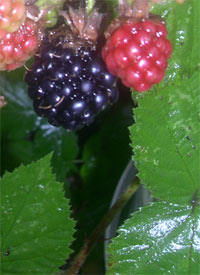Blackberry and apple jam recipe
Posted by Fiona Nevile in Jam Jelly and Preserves | 237 comments It was Anne Mary that pointed out that apple and blackberry jam would be full of blackberry pips.
It was Anne Mary that pointed out that apple and blackberry jam would be full of blackberry pips.
“They’d get stuck in your teeth and drive you mad. Stick to bramble jelly.”
I love jelly. We make loads of jelly every year. More often than not it is used as a base for a sauce rather than dolloped on a plate of roast lamb or pork.
Imagine my delight when I found this recipe for Blackberry and Apple Jam in my aunt’s ancient handwritten cookbook. As it is sieved there are no seeds and the jam is delicious, spread on hot buttered toast in the morning.
Blackberry and Apple Jam recipe
Ingredients:
- 1k (roughly 2lb) of blackberries
- 350g (12ozs) of apples (eating apples, windfalls are fine)
- Water
- White granulated sugar
Method:
- Core and roughly chop the apples (skin on).
- Put the apples, cores and blackberries in a large preservaing pan or large heavy bottomed saucepan. Add just enough water to cover and simmer until soft.
- Sieve the softened fruit and weigh the sieved pulp (discard the skins and seeds left in the sieve). Add 450g (1lb) of sugar for each 450g (1lb) of sieved pulp.
- Put sieved pulp and sugar into a large heavy bottomed saucepan (or preserving pan) and heat very gently until the sugar has dissolved.
- Bring the jam to the boil and continue to boil very rapidly for about 8-10 minutes until the jam reaches setting point. (What is setting point? See tricks and tips below).
- When the jam has set, carefully pour into warm, sterilised jars, using a ladle or small jug (How to sterilise jars? See tricks and tips below)
- Cover the jars with tight fitting screw-top lids, or waxed disks and cellophane pot covers (waxed disks, wax facing downwards and plastic covers secured with plastic bands).
- Label when cold and store in a cool, dark place, away from damp.
Tricks and Tips:
- Jam “set” or “setting point”:
Getting the right set can be tricky. I have tried using a jam thermometer but find it easier to use the following method. Before you start to make the jam, put a couple of plates in the fridge so that the warm jam can be drizzled onto a cold plate (when we make jam we often forget to return the plate to the fridge between tests, using two plates means that you have a spare cold plate). Return the plate to the fridge to cool for approx two minutes. It has set when you run your finger through it and leave a crinkly track mark. If after two minutes the cooled jam is too liquid, continue to boil the jam, testing it every few minutes until you have the right set. The jam is far more delicious if it is slightly runny. - Sterilising the jars:
We collect jars all year round for our jelly, chutney and jam making sessions. I try to soak off labels and store the clean jars and metal plastic coated screw-top lids in an accessible place. The sterilising method that we used is simple. Just before making the jam, I quickly wash and rinse the jars and place them upside down in a cold oven. Set the temperature to 160c/140c for fan assisted. When the oven has reached the right temperature I turn off the heat. The jars will stay warm for quite a while. I only use plastic lined lids for preserves as the all-metal lids can go rusty. I boil these for five minutes in water to sterilise them. If I use Le Parfait jars, I do the same with the rubber rings.
Leave a reply





Hi Dawn
Discard the stuff in the sieve. Match the weight of the sieved stuff with the weight of the sugar.
Hi I am making the jam now do I weigh the sieived stuff to find out how much sugar to add or the stuff that is left in the seive thanks
Hello Melva
So sorry not to have responded before now.
We have several damson recipes on this site. Just type ‘damson’ in the search box at the top of the page.
i want a quick recepie for damson perserves with out apples just damsons thanks
Hello Alan,
So pleased that it will be useful!
The conversion table is brilliant it will make life a lot easier, Thank You
Alan Beadling
Hello A Beadling,
I have put the conversions on the recipe for you. There is a very good site that does the conversions for you http://www.dianasdesserts.com/index.cfm/fuseaction/tools.measures/Measures.cfm
which could be useful in the future for you.
Thanks for the tip on jars. We have a crabapple jelly recipe here https://www.cottagesmallholder.com/?p=470
I cannot come to terms with the metric measures could you please put in brackets what it is in plain English ( at 74yrs I think I am to old to learn metric) as for the jam jars I put mine in the dishwasher and then heat them up in the microwave oven.I have yet to try Crab-apple Jelly any tips ?
Hi Louisa,
I would definitely use the hot method for sealing your jars next time. Our spare bedroom is cool and dry.
So pleased that you are enjoying the site!
Many Thanks for your help, i will try storing in the bedroom next time. i’ve been trawling through the net and most places say to put the lids on the jam straight away while hot, whereas the article i read said to let it cool first, will use the hot method next time. great site gives me hours of pleasure. x